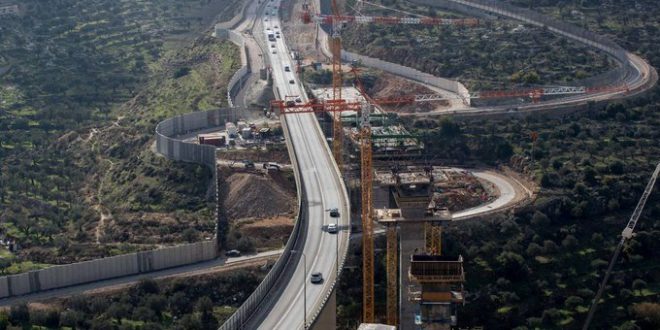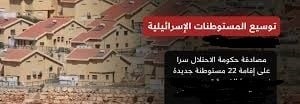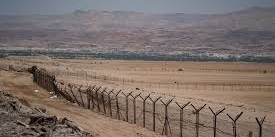By: Madeeha Al-A’raj
The National Bureau for defending land and resisting settlements ( nbprs ) stated in its latest weekly report , that several indicators on the ground show that Israel has lifted the annexation plan from the table only to deceive the public opinion and the International Community, at a time when the infrastructure for the annexation project is implemented through ‘bypassing annexation’ settlement units, and streets among the settlements aiming to turn the West Bank by 2045 into a new Galilee
A source connected to those plans explained to ‘Haaretz Nnewspaper’ last week that what is new in the plans lies in their connection with the main Qatari construction plan in Israel, as there is talk of a change in the approach of the occupation authorities, which previously refrained from including the West Bank in long-term plans. The source clarifies that during 50 years the State of Israel didn’t plan in ‘Judea and Samaria,’said, Yigal Dilmuni, Director General of the Settlements Council.
With the administration of US President Donald Trump, the situation changed and the thinking began to build a network of longitudinal and latitudinal roads, some of them new and others are old. On paper, this is done for the benefit of all residents in the West Bank, including Palestinians and settlers, but on the ground totally something else. The main goal is to expand the settlements up to the “million Jews in the West Bank over the upcoming 15 years. The same source confirms that each of these projects has a price on the land for the Palestinians. With a broader look, we can see a kind of annexation plan of another kind, specifically in infrastructure. The same source confirms that each of these projects has a price on the ground for the Palestinians, where about 401 donums of the Palestinian land were confiscated. In Hawara, about more than 406 donums, i.e. uprooting of hundreds of trees, in addition to expanding settlements and linking them to the occupation state, restricting the freedom of movement of Palestinians, besieging them in their villages and towns, and striking their economy, which means turning settlements into desirable cities and towns, and attractions for the Israelis.
The Israeli Minister of Transportation, Miri Regev, approved 4 new settlement projects in the West Bank, with the aim of facilitating the movement of settlers, at a cost of NIS 400 million. The projects are: Al-Laban Al-Gharbi bypass road at a cost of NIS 100 million, Modi’in Illit Street 446 to connect the Modi’in Illit settlement with the Lapid settlement at a cost of NIS 171 million, Adam Street – Hazma for the benefit of the settlers in the settlement of Beit El at a cost of NIS 17 million, and a street that includes building a bridge over Qalandia to Jerusalem with new checkpoints, and NIS 103 million has been allocated for the project, besides, allocating a budget of NIS 400 million to develop transportation in the settlements. Last month, Regev presented a long-term strategic plan for a new transportation network linking settlements in the occupied West Bank.
The plan includes plans for the next twenty years, and includes bypass roads linking settlements. The plan includes new projects, including a new road bearing NO. 80. The plan also include new bypass streets, called ‘Huwara, Beit Umar and Al-Aroub bypass roads. In addition to developing and expanding Street 55 from Street 6 to Street 60. The expansion of road 437 in the Hizma checkpoint area and road 375 from the Tzur Hadassah settlement in Jerusalem to the Hosan Junction, and the expansion of road 446 between the settlements of Sheilat and Modiin, in addition to the expansion of road 505 between the settlers of Tabuah and Ariel. These projects will be divided into 3 phases: the first is short-term, which ends in 2025, the other is medium-term and ends in 2035, and the last is long-term, and ends in 2045.
In Jerusalem and its environs, the occupation government does not stop its settlement projects, as it aims to create a large settlement belt around Jerusalem by constructing new settlement roads and streets aimed at preventing any expansion or geographical contact of the people of Jerusalem from the south as part of the so-called ‘Jerusalem Envelope Belt.’ The occupation municipality in Jerusalem began its actual steps aimed at paving a new road at the beginning of next year, linking the new settlement outpost, Mordot, with the settlement of Gilo, south of occupied Jerusalem, at the expense of the confiscated Palestinian lands belonging to the residents of Walaja, Beit Safafa and the area south of Jerusalem, and it has been confiscated since It is planted with olive trees, almonds, carob and others for years, and its owners are forbidden to use it.
The company owned by it, “Moria”, was commissioned with the implementation work, according to what was stated at the conclusion of the meeting of the mayor of the occupation, Moshe Lion with the residents of that outpost, with the participation of the city engineer and a number of members of the municipality of “Gilo” settlement . In a statement, the occupation municipality stated that about 1500 new settlers are living in the new settlement neighborhood, “Mordot”, which was added to “Gilo” settlement with 350 units, while it is expected that about 550 new settlers will be added next year and they are under approval, and bids will be issued for them within 45 days.
In another step towards completing annexation and expansion plans, an engineering company affiliated to the occupation authorities undertook surveying lands for citizens in the villages of Qarawat Bani Hassan and Sarta, west of Salfit governorate, in addition to Khirbet al-Hama and Mafraq al-Malih in the northern Jordan Valley. Qarawat Bani Hassan and Sarka, with an area of about 89 dunums, is adjacent to the settlement of Ma’ale Israel, close to the Barkan settlement industrial and residential area, and it also included targeting the lands of “Khallet Hodeidah” belonging to Qarawah and Haris, where sweeping work continues until the moment with the aim of settlement expansion.
In the Nablus governorate, the occupation forces have notified to seizing about a thousand donums of agricultural lands from the villages of Burin, Madama, and Asirah al-Qibli, south of Nablus with the aim of expanding the settlement of Yitzhar, and building a security road serving settlers.
List of Israeli Assaults over the Last Week Documented by the National Bureau:
Jerusalem:
- Calling on Jewish extremists to break into the Al Aqsa Mosque, and turn this winter into a ‘Jewish winter’.
- Launching a program coincides with the so-called Jewish Ennouar Day ‘Hakonah Day’ from 10th to 18th of this month.
- Attacking a number of Palestinian in the Wadi Al-Rababa Neighborhood of Silwan town.
- Breaking into the Neighborhoods of Silwan and photographed several facilities and neighborhoods, distributed demolition notices, and summons to review the municipality under the pretext of not having a building permit.
Hebron:
- Demolishing a tin house in the Bereen area, south of Hebron, belonging to Akram Abu Dawood in addition to demolishing water well and agricultural barn belonging to Ghayad Al-Salamin in the Al-Simiya area, which is inhabited by 300 citizens, and photographing the water line in Idqiq area in the Masafer Yata.
- Preventing the farmers in the Al-Tha`la area, east of Yatta, from reaching their lands threatened with seizure, and preventing the Susiya school’s teachers from accessing their school in the Masafer Yatta as well.
- Notifying to demolish six houses, two water collecting wells and four agricultural rooms of tin in the Al-Jawaya Gathering east of Yatta, near the Ma’on settlement, belonging to the Al-Nawajaa and Al-Shawahin families, under the pretext of not having a building permit.
- Erecting a mobile house on a 50 dunums hill in the Baqaa area, belonging to Arif Jabro, in an attemot to seize it.
Bethlehem:
- Demolishing two rooms of bricks and roofed with iron in the Al-Minya village near the Taqoa town southeast of Bethlehem, belonging to Jasir Abd Al-Hamid Aramine, under the pretext of not having a building permit.
- Attacking large grazing lands belonging to the Keisan village, and threatened a number of shepherds to evict it under the pretext of being closed military areas.
- Bulldozing a 6-donum area in the Al-Abbasiya area belonging to Rizk Mohamad Hussein Salah, this led to the uprooting of 100 olive trees and 50 vine seedlings. It should be noted that it is the Israeli third time in a row to force the Palestinian to leave it.
- Demolishing an agricultural barn in the Minya village, east of Bethlehem, belonging to Yasser Abdel Hamid Aramin, under the pretext of not having a building permit.
- Demolishing retaining walls and bulldozed agricultural lands in the Khilat Al-Nahla area, south of Bethlehem.
Jordan valley:
- Notifying to remove tents in the Hammamat Al Maleh area in the northern valleys.
- Erecting caravans in the Al-Faresyiah area, which is witnessing a new wave of systematic operations targeting the Palestinian presence in the valleys.
- Preventing farmers from working in their lands in the Atouf village in the northern valleys.
- Seizing two bulldozers belonging to Dia’ Ibrahim Bani Oda, and Ayman Rabah Gharib Bani Oda while working in their lands.
- Demolishing 7 houses and expelled 44 of its inhabitants in the Shalal Al-Oja Gathering to the north of Jericho.
Jenin:
- Storming the Tersala area near the Jaba town which was evacuated in 2005, chanted racist slogans against the Arabs and Muslims. Moreover, they performed Talmudic rituals, under strict Israeli protection which led to clashes between the Palestinian and the Israeli forces who fired sound and tear gas bombs causing many injuries and suffocations at the Jaba’ Junction.
 المكتب الوطني للدفاع عن الارض ومقاومة الاستيطان منظمة التحرير الفلسطينية
المكتب الوطني للدفاع عن الارض ومقاومة الاستيطان منظمة التحرير الفلسطينية




